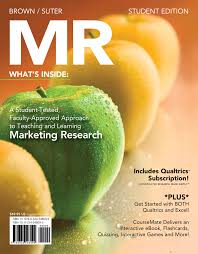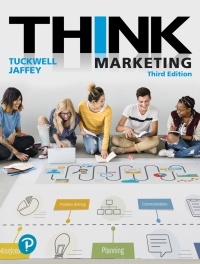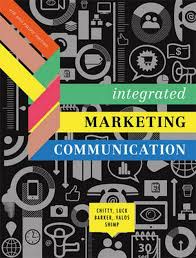Description
Test Bank For MR 1st Edition by Tom J. Brown
Chapter 3 — Exploratory, Descriptive, and Causal Research Designs
MULTIPLE CHOICE
1. The descriptive study:
a.
usually takes the form of an experiment.
b.
has its major emphasis on the discovery of insights and ideas.
c.
is concerned with determining the frequency with which something occurs.
d.
is concerned with the determination of a cause-and-effect relationship.
e.
has as its main objective the establishment of priorities for future research.
ANS:CPTS:1
NAT:AACSB Analytic | CB&E Model Research | Bloom’s: Knowledge
2.Which of the following is FALSE?
a.
In exploratory research, the major concern is with the discovery of ideas and insights.
b.
Exploratory research is often used to clarify concepts and to establish priorities for further research.
c.
Exploratory research investigates hypotheses.
d.
Exploratory research is used to develop hypotheses.
e.
Exploratory studies do not lend themselves very well to the use of structured questionnaires.
ANS:CPTS:1
NAT:AACSB Analytic | CB&E Model Research | Bloom’s: Knowledge
3.A causal research design is typically concerned with:
a.
the frequency with which something occurs.
b.
the discovery of ideas and insights.
c.
how two variables vary together.
d.
the determination of cause-and-effect relationships.
e.
establishing priorities when studying competing explanations of phenomenon.
ANS:DPTS:1
NAT:AACSB Analytic | CB&E Model Research | Bloom’s: Knowledge
4.The major emphasis in exploratory research is on:
a.
determining the frequency with which something occurs.
b.
the discovery of ideas and insights.
c.
the relationship between two variables.
d.
determining cause-and-effect relationships.
e.
providing definitive answers.
ANS:BPTS:1
NAT:AACSB Analytic | CB&E Model Research | Bloom’s: Knowledge
5.A hypothesis:
a.
is a conjectural statement about the relationship between two variables that are measurable or potentially measurable.
b.
is a broad, vague problem statement.
c.
cannot be discovered during research.
d.
does not have clear implications for testing the relationship between variables.
e.
is only found in the causal type of research.
ANS:APTS:1
NAT:AACSB Analytic | CB&E Model Research | Bloom’s: Knowledge
6.The manager of Capitol Brewing Inc. states that he is very concerned with the continuing decline in sales of the company’s major product, a dark lager. The manager has asked for your assistance in finding the reasons for the sales decline. The most appropriate way to begin would be with:
a.
exploratory research.
b.
descriptive research.
c.
causal research.
d.
an experiment.
e.
a consumer study.
ANS:APTS:1
NAT:AACSB Analytic | CB&E Model Research | Bloom’s: Application
7.Which research design(s) is (are) typically guided by an initial hypothesis?
a.
Causal
b.
Descriptive
c.
Exploratory
d.
Exploratory and causal
e.
Descriptive and causal
ANS:EPTS:1
NAT:AACSB Analytic | CB&E Model Research | Bloom’s: Knowledge
8.The descriptive study:
a.
usually takes the form of an experiment.
b.
has its major emphasis on the discovery of insights and ideas.
c.
is concerned with determining the frequency with which something occurs.
d.
is concerned with the determination of a cause-and-effect relationship.
e.
has as its main objective the establishment of priorities for future research.
ANS:CPTS:1
NAT: AACSB Analytic | CB&E Model Research | Bloom’s: Comprehension
9.Using different ads in different geographic areas and investigating which ad generated the highest sales is an example of _____ research design.
a.
causal
b.
exploratory
c.
longitudinal
d.
descriptive
e.
panel
ANS:APTS:1
NAT: AACSB Analytic | CB&E Model Research | Bloom’s: Comprehension
10.A literature search is a type of _____.
a.
causal research
b.
exploratory research
c.
experimental research
d.
descriptive research
e.
Both b and c.
ANS:BPTS:1
NAT:AACSB Analytic | CB&E Model Research | Bloom’s: Knowledge
11.One of the quickest and most economical ways to discover hypotheses is through:
a.
a sample survey.
b.
the use of a panel.
c.
the analysis of selected cases.
d.
an experience survey.
e.
a literature search.
ANS:EPTS:1
NAT:AACSB Analytic | CB&E Model Research | Bloom’s: Knowledge
12.Exploratory studies:
a.
usually involve probability sampling plans.
b.
usually use structured questionnaires.
c.
use a formal design.
d.
are characterized by flexibility.
e.
require a clear, precise statement of the research problem.
ANS:DPTS:1
NAT:AACSB Analytic | CB&E Model Research | Bloom’s: Knowledge
13.The manager of the Golden Orange Drink Company states that he is very concerned with the continuing decline in sales of the company’s major product, a concentrated orange drink. The manager has asked for your assistance in identifying the reasons for the sales decline. The most appropriate way to begin would be with:
a.
a case analysis.
b.
an experiment in which price is systematically varied.
c.
descriptive research.
d.
a controlled market test.
e.
exploratory research.
ANS:EPTS:1
NAT:AACSB Analytic | CB&E Model Research | Bloom’s: Application
14.The primary purpose of a literature search is to:
a.
discover the cause of a marketing problem.
b.
derive hypotheses.
c.
discover internal problems.
d.
identify the appropriate sample size.
e.
discover the explanation for a marketing problem.
ANS:BPTS:1
NAT:AACSB Analytic | CB&E Model Research | Bloom’s: Knowledge
15.In general, the first step in conducting exploratory research should be:
a.
assembling a focus group.
b.
performing an experience survey.
c.
conducting a literature search.
d.
performing an analysis of selected cases.
e.
narrowing a group of hypotheses to one specific hypothesis for investigation.
ANS:CPTS:1
NAT:AACSB Analytic | CB&E Model Research | Bloom’s: Knowledge
16.A small group of people brought together to discuss a topic of interest to researchers is known as a(n):
a.
task force.
b.
guidance committee.
c.
experience group.
d.
focus group.
e.
development group.
ANS:DPTS:1
NAT:AACSB Analytic | CB&E Model Research | Bloom’s: Knowledge
17.A focus group:
a.
consists of an interviewer and a subject discussing a single topic of interest.
b.
is not useful for testing hypotheses.
c.
typically consists of four to six members.
d.
requires selecting members with different socioeconomic backgrounds.
e.
involves having subjects fill out a survey on one topic.
ANS:BPTS:1
NAT:AACSB Analytic | CB&E Model Research | Bloom’s: Knowledge
18.The key to an effective focus group is:
a.
members experienced in focus group participation.
b.
the skills of the moderator.
c.
participants’ prior familiarity with each other.
d.
an appropriate location.
e.
None of the above.
ANS:BPTS:1
NAT: AACSB Analytic | CB&E Model Research | Bloom’s: Comprehension
19.Which of the following best represents the objective of the moderator in conducting a focus group?
a.
Staying very focused on the subject at hand.
b.
Allowing for a free-flow of ideas that are unrestricted and therefore more conducive to creativity.
c.
Striking a balance between stimulating, natural discussions while ensuring the group does not wander too far from the topic.
d.
To conduct as many persons through the group as possible during the time allowed; this enables the results to be more representative.
e.
The moderator must be completely unfamiliar with the purpose of the research.
ANS:CPTS:1
NAT:AACSB Analytic | CB&E Model Research | Bloom’s: Knowledge
20.Focus groups have proven productive for all of the following, EXCEPT:
a.
determining the feelings of the general population.
b.
generating hypotheses to be tested further.
c.
stimulating ideas for new products.
d.
interpreting previously obtained results.
e.
developing lists of characteristics on which consumers evaluate products.
ANS:APTS:1
NAT:AACSB Analytic | CB&E Model Research | Bloom’s: Knowledge
21.Which of the following statements about focus groups is FALSE?
a.
Most focus groups consist of 8 to 12 members.
b.
Respondents for groups are generally selected so that they are relatively homogeneous.
c.
Firms like to recruit people who have not participated in a focus group previously.
d.
Firms like to have groups in which some of the participants are friends.
e.
Professional moderators tend to produce better discussion than those more intimately involved in the research.
ANS:DPTS:1
NAT:AACSB Analytic | CB&E Model Research | Bloom’s: Knowledge
22.A claimed advantage of the focus group interview is an interaction effect where a comment by one individual often triggers a chain of responses from the other participants. This is known as
a.
synergism.
b.
serendipity.
c.
stimulation.
d.
snowballing.
e.
None of the above.
ANS:DPTS:1
NAT:AACSB Analytic | CB&E Model Research | Bloom’s: Knowledge
23.Benefits of focus groups include:
a.
ideas that can drop “out of the blue.”
b.
snowballing of ideas.
c.
more spontaneous responses than in one-on-one interviews.
d.
easy interpretation of responses.
e.
a, b, and c.
ANS:EPTS:1
NAT:AACSB Analytic | CB&E Model Research | Bloom’s: Knowledge
24.A difficulty inherent in the focus group research technique is:
a.
results are often hard to interpret.
b.
discussions tend to exhibit the “snowball effect.”
c.
ideas often appear “out of the blue.”
d.
participants can become so involved that they expose their personal feelings.
e.
responses are often less conventional than in more structured settings.
ANS:APTS:1
NAT:AACSB Analytic | CB&E Model Research | Bloom’s: Knowledge
25.Which of the following is a limitation of individual depth interviews?
a.
They are typically much more expensive than groups.
b.
They generally do not get the same degree of client involvement as focus groups.
c.
They are physically exhausting for the moderator, so it is difficult to cover as much ground in one day as it is with groups.
d.
Only a and b
e.
a, b, and c.
ANS:EPTS:1
NAT: AACSB Analytic | CB&E Model Research | Bloom’s: Comprehension
26.The “analysis of selected cases” technique is an example of which type of research design?
a.
Exploratory
b.
Experience
c.
Causal
d.
Case study
e.
Descriptive
ANS:APTS:1
NAT:AACSB Analytic | CB&E Model Research | Bloom’s: Knowledge
27.Analysis of selected cases refers to:
a.
intensive study of selected examples of the phenomenon of interest.
b.
descriptive designs.
c.
a market test in a standard test market.
d.
the sampling frame.
e.
the analysis of the data gathered from a controlled market.
ANS:APTS:1
NAT:AACSB Analytic | CB&E Model Research | Bloom’s: Knowledge
28.Which of the following is FALSE?
a.
Benchmarking involves identifying one or more organizations that excel at carrying out some function and using their practices as a source of ideas for improvement.
b.
Organizations can carry out benchmarking by reading about other organizations or by visiting or calling them.
c.
Benchmarking is more useful for learning about new products than existing products.
d.
The process of benchmarking varies according to the information needs of the organization and the resources available.
e.
Benchmarking is an example of the use of selected cases to develop insights into a phenomenon.
ANS:CPTS:1
NAT:AACSB Analytic | CB&E Model Research | Bloom’s: Knowledge
29.A Mexican Restaurant owner often visits competitor’s restaurants in order to gather visual information about menu selections, prices, ambiance, and service quality to benchmark against. What type of research is the owner performing?
a.
Exploratory
b.
Basic
c.
Descriptive
d.
Causal
e.
Field
ANS:APTS:1
NAT:AACSB Analytic | CB&E Model Research | Bloom’s: Application





Be the first to review “Test Bank For MR 1st Edition by Tom J. Brown”